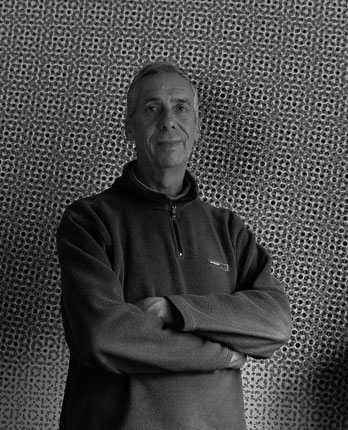Né en 1958 à Lyon
Vit et travaille dans les Alpes Maritimes
« Si la persistance de la pratique du graffiti incisé le plus souvent sur l’enduit d’un mur ou l’écorce d’un arbre ne cesse de m’étonner, l’immuable beauté du portrait flamand et de son océan de visages m’enchante tout autant. L’ironie suggérée, il sera temps de remarquer que ce qui les unit relève bien d’un même registre, celui d’un ensemble de milliers d’existences anonymes secrétant une égale délectation pour leur propre singularité. Nés tous deux d’un système quasi mécanique, codifié, inlassablement recommencé, leur incroyable présence traverse pourtant le temps ; néanmoins, revendiquant pour l’un son aspect populaire et pour l’autre son appartenance à une aristocratie assumée, force est de constater qu’une fonction mémorielle commune les rassemble telle une identique référence.
Pratiquant ouvertement l’idée d’une histoire de l’art au cœur de ma production artistique, l’usage du vernis s’est imposé, celui-ci apportant brillance et dureté à la peinture. En fait, le fameux « éclat » dont parlait Van Eyck, cet éclat proche du verre, du vitrail, proche aussi d’un épiderme censé protéger un monde organique et fragile.
La peinture est une chambre hermétique dans laquelle se débat une suite d’interventions singulières, de choix contradictoires et d’hésitations heureuses.
Dans le vertige du monde où tout vacille, où il n’est plus de modèle fiable, l’image opposera t-elle encore sa capacité d’éblouir, son pouvoir d’être, pour enfin exister telle qu’elle se conçoit ?
Tel est le fond de mon travail. L’art pariétal, cet art dit des cavernes, reste à mes yeux la rencontre la plus forte. Peut-être par le silence qui l’enveloppe, celui qui rend impossible toute explication.
Voir, regarder, observer, admirer”.

JUBILANT DICHOTOMY
Daniel Airam’s painting is doubly fascinating. On one hand, it offers a figuration imbued with the quintessence of ancient art, particularly Flemish art from the 15th to 17th centuries. The homage is overt, and the beauty of the portraits exudes an incredible modernity. On the other hand, it engages in a vertiginously contemporary approach through scarifications, graffiti, and engraved words that play with our emotions and prompt us to question not only the passage of time (the artwork seems to have lived) but also humanity’s delirious propensity to leave its mark on everything it touches—from a simple tree trunk to the most renowned monuments.
“The persistence of the practice of graffiti, most often etched into the plaster of a wall or the bark of a tree, never ceases to amaze me, just as the timeless beauty of Flemish portraiture and its ocean of faces continues to enchant me,” the artist explains, adding: “With irony suggested, it is worth noting that what unites them stems from the same realm: a vast collection of anonymous lives, each secreting an equal delight in their singularity.”
A curious anecdote of our time: as I write these lines, a guard at the Boris Yeltsin Art Center in Ekaterinburg, Russia, has had his fifteen minutes of fame after being accused of scribbling ‘eyes’ onto a painting by Anna Leporskaya (1900–1982), entitled The Three Figures, completed in 1934 and valued at €880,000. Here, reality meets fiction, in a way.
Through this delightful dichotomy (portrait and graffiti), rooted at the very heart of representation, Daniel Airam breathes new life into so-called classical painting, incorporating it into a resolutely temporal perspective and adding a sort of “lees” that might be conceived, in some ways, as “the angels’ share” of time—a kind of “baroque” residue made of signs and words. Daniel Airam’s painting is at once heritage and pure creation.
Upon closer examination, the words he inscribes at the heart of his paintings, like a sort of frontispiece, are Latin terms: pactum, solarius, operte, consonus, etc. These words resonate like subliminal messages meant to add an extra layer of mystery—or lightness, as one might prefer. Here, painting holds the power to both intrigue and dazzle.
The artist’s credo, “To see, to look, to observe, to admire,” aligns perfectly with this atypical figuration, to which varnish adds brilliance and hardness, giving it, as Daniel Airam himself says, that famous “sheen” Van Eyck spoke of—this sheen akin to glass, stained glass, or an epidermis designed to protect a fragile, organic world.
Miroir de l’Art #115
| Expositions 2023 – 2018 | Expositions 2017 – 1998 |
|---|---|
| 2023 Antica Namur Art Fair, solo show, galerie “Au-delà des apparences” Lausanne Art Fair, Bel Air Fine Art Galerie CONTEXT Art Miami, Bel Air Fine Art Galerie Moderne Art Fair Paris, Bel Air Fine Art Galerie Réalisation d’une collection textile par Artist Le Studio BF à partir du tableau « Didon et Enée » Art’up Lille, solo show, galerie au-delà des apparences 2022 2021 2020 2019 2018 |
2017 Galerie Patrick Bartoli, Marseille (p) 2016 2012 2011 2010 2006 2001 2000 1999 1998 Participe à de nombreuses expositions collectives en France, Europe, États-Unis, Japon. |
To provide the best experiences, we use technologies such as cookies to store and/or access device information. Consent to these technologies will allow us to process data such as browsing behavior or unique IDs on this site. Not giving or withdrawing consent may have a negative effect on certain features and functions.